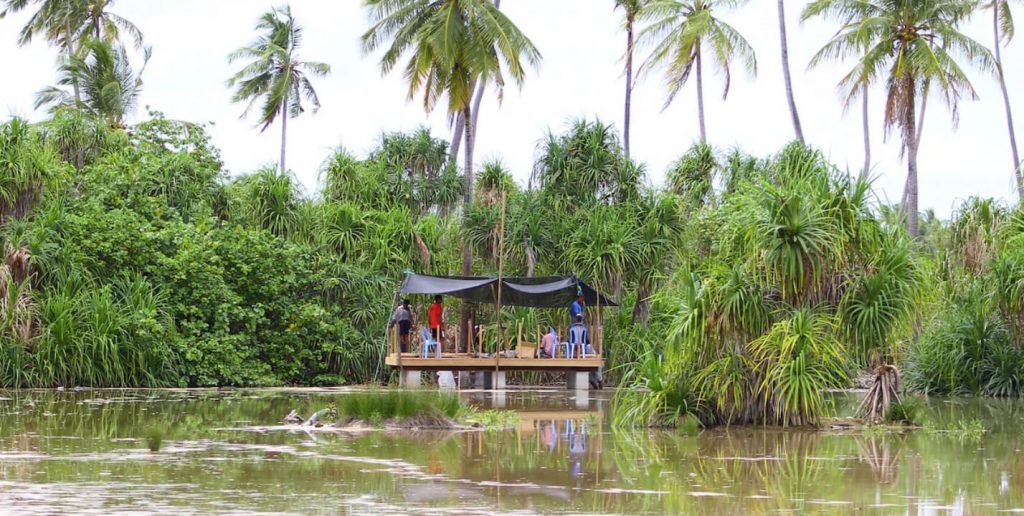The spectacular island, lagoon and reef of HDh Nolhivaranfaru is home to some of the most stunning sunsets, mesmerizing beaches and a beautiful mangrove. This island, which experienced population consolidation in the past with people of HDh Faridhoo, Kunburudhoo and Maavaidhoo, is also the resting spot of the Atoll Chief of Northern Atolls in the 16th century Edhurukaleyfaanu. Our focus today is on the Bodukulhi of Nolhivaranfaru.
The Bodukulhi of Nolhivaranfaru is a shallow water body with a rocky bottom. Small-leafed Orange Mangrove (Dhivehi: Kan’doo, Bruguiera cylindrica) trees line the perimeter of the water body. The exposed sedimentary rocks with small rocks at the surface indicates that it used to be a shallow lagoon with a lot of rocks. In some areas, the rocky bottom is covered with about a 300 to 600 mm thick layer of mud.
The Vegetation of the Area
Small-leaved Orange Mangrove, kan’doo, seedlings are found closer to the lagoon on the beach area, while large trees further inland act as a coastal defense holding the soil together. In addition to the kan’doo, patches of Ironwood (Dhivehi: kuredhi, Pemphis acidula) and Sea Trumpet (Dhivehi: kaani, Cordia subcordata) trees are also found along the perimeter of the water body (kulhi). The Kulhi and sea are separated by a mangrove belt of about 20 to 30 feet in width. This mangrove is also subject to tidal flooding with saltwater entering during high tide. Mangrove snails were found to be extremely abundant at Bodukulhi.
Near the kulhi, we also found two Cannonball Trees (Dhivehi: marugas, Xylocarpus moluccensis) near the beach. This type of mangroves are considered to be extremely rare in the Maldives. The Nolhivaranfaru School environment club has made admirable efforts to create and attach information sheets to these trees. They seem to be dated by a couple of years and are now weathering without proper care. We encourage the environment club of Nolhivaranfaru School to continue this useful project!
One of the most disheartening sights to see, as with most beaches and lakes now, was the problem of plastic – a lot of plastic bottles were found near the mangrove which were washed ashore during high tide.


The Past Glory of the Bodukulhi
The locals recount tales of the kulhi being deeper than it is today and full of milk fish. In the past, the community benefited from harvesting milk fish as seasonal staple food when the seas were too rough to go for tuna fishing in the south-west monsoon. The mud-crabs in the area are also said to have been abundant in the past, but were a rare sight during out trip to Bodukulhi. Similarly, the bird population has reportedly dropped – but even during our brief time there, we were able to spot two Northern Shovelers (Dhivehi: reyru, Anas clypeata) and one Grey Heron (Dhivehi: maakanaa, Ardea cinerea).
Perhaps one of the explanations for these changes in the Bodukulhi stem from the 2004 Asian Tsunami. The island was severely damaged when waves washed ashore from both sides of the island. The flooding caused by tsunami remained 4 feet deep until eventually subsiding. Although many houses got flooded and belongings got swept away, everyone on the island survived the tsunami. However, the mangroves were not as lucky. Locals report that since the tsunami, the trees have became weaker, the milk fish disappeared and the kulhi became much shallower than before.

Kitchens That’ll Make You Want To Redo Yours
In the past, the locals of Nolhivaranfaru also collected kandoo as a staple food. For it to be edible, it s boiled in water until it softens and is then washed in water about 5-6 times until all the color disappears. This also serves to remove the bitterness inherent in Kandoo. Moreover, the water body was also used to bury count husks as part of the process of making coir rope. In addition to the Bodukulhi, a smaller lake called Kudakulhi is found nearby with dense patches of various trees that were also found at Bodukulhi. This area has an abundance of Red Mangroves (Dhivehi: ran’doo, Rhizophora mucronata). Muddy areas with water are also used to bury coconut husk in this kulhi.
This traditional economic activity has slowly died down in the past years as the area was closed for a resort development project. As of now, this resort development project has still not begun.




